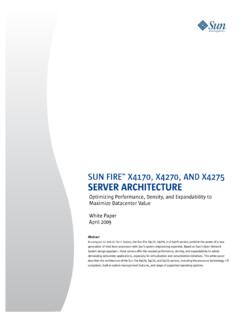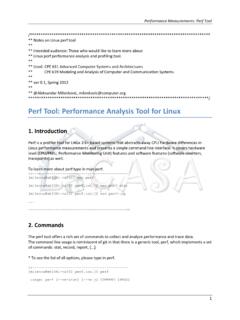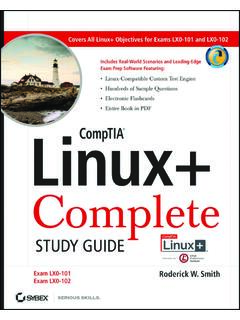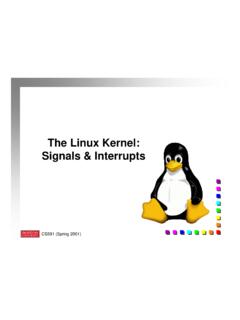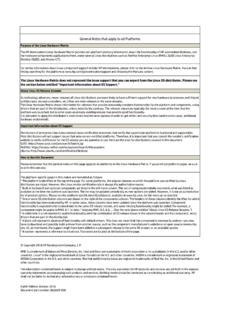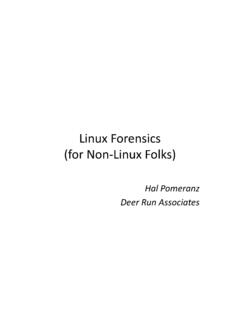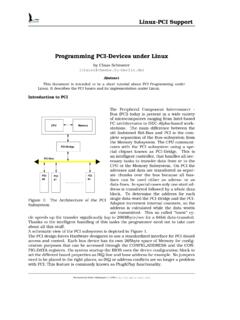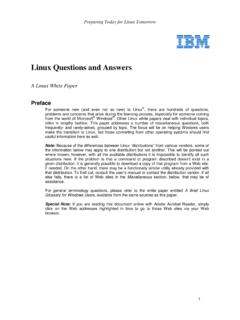Transcription of HowTo - High Performance Linpack (HPL) - CRC
1 HowTo HPL Mohamad Sindi - 2009 1 HowTo - high Performance Linpack (HPL) This is a step by step procedure of how to run HPL on a linux cluster. This was done using the MVAPICH MPI implementation on a linux cluster of 512 nodes running Intel s Nehalem processor MHz with 12GB of RAM on each node. The operating system that was used is RedHat Enterprise linux The interconnectivity between the nodes was via Infiniband 4x-DDR using the standard RedHat EL drivers. You can use my simple PHP web tool to enter you system specs and it will suggest for you optimal input parameters for your HPL file before running the benchmark on the cluster. The tool can be accessed via the URL below: First of all, as root or normal user, you need to compile MVAPICH over Infiniband, Intel compiler, and Intel MKL to get the best results out of the Nehalem processor as Intel recommends.
2 This will produce the optimal mpirun binary to be used to launch HPL on the cluster nodes. Install the below development rpms for Infiniband since they will place a few header files that are needed during the build under /usr/include/infiniband: [root@node lib64] rpm -ivh [root@node lib64] rpm -ivh [root@node lib64] rpm -ivh Compile and install MVAPICH (Options in red are required for TotalView debugger to work with MVAPICH) cd /usr/src wget tar zxvf cd cp vi (Edit this file to point to our compilers and installation folder as below) ======================================== =================================== Add intel compilers and remove XRC from the cflags IBHOME=${IBHOME:-/usr/include/infiniband } IBHOME_LIB=${IBHOME_LIB:-/usr/lib64} PREFIX=${PREFIX:-/usr/local/mpi/mvapich/ } export CC=${CC:-/usr/local/ } export CXX=${CXX:-/usr/local/ } export F77=${F77:-/usr/local/ } export F90=${F90.}
3 -/usr/local/ } HowTo HPL Mohamad Sindi - 2009 2 export CFLAGS=${CFLAGS:--D${ARCH} ${PROCESSOR} ${PTMALLOC} -DEARLY_SEND_COMPLETION -DMEMORY_SCALE -DVIADEV_RPUT_SUPPORT -D_SMP_ -D_SMP_RNDV_ -DCH_GEN2 -D_GNU_SOURCE ${COMPILER_FLAG} -I${IBHOME}/include $OPT_FLAG} ======================================== =================================== ./configure --enable-debug --enable-sharedlib --with-device=ch_gen2 --with-arch= linux -prefix=${PREFIX} $ROMIO --without-mpe -lib="$LIBS" 2>&1 |tee export MPIRUN_CFLAGS="$MPIRUN_CFLAGS -g" . Now do the HPL installation as a normal user, in this case I used my id chewbacca with the shared home directory being mounted from the master node of the cluster on all nodes. I did the compilation on the master node since it has full packages installed on it but ran the actual benchmark from a compute node since it has an Infiniband card and the master doesn t.
4 [root@node ~] su - chewbacca [chewbacca@node ~]$ mkdir hpl [chewbacca@node ~]$ cd hpl/ Download the source code for HPL Untar and prepare Make file for compilation [chewbacca@node ~/hpl]$ tar -xzvf [chewbacca@node ~/hpl]$ cd [chewbacca@node setup]$ sh make_generic This generates a template for us [chewbacca@node setup]$ cp .. [chewbacca@node setup]$ cd .. [chewbacca@node ]$ You might need to install some compatibility libraries on all nodes depending on your system yum install HowTo HPL Mohamad Sindi - 2009 3 Modify the Make file and point it to our compilers and libraries, also note that we tell it to use the MKL and BLAS libraries from Intel to enhance the Performance on the Nehalem. [chewbacca@node ]$ vi ---------------------------------------- ---------------------------------------- ------------------- ARCH = linux TOPdir = /home/ecc_11/chewbacca/ MPdir = /usr/local/mpi/mvapich/ MPlib = -L$(MPdir)/lib LAdir1 = /usr/local/ LAdir2 = /usr/local/ LAlib = -L$(LAdir1) -L$(LAdir2) -lclusterguide -lmkl_intel_lp64 -lmkl_sequential -lmkl_core CC = $(MPdir)/bin/mpicc LINKER = $(MPdir)/bin/mpicc ---------------------------------------- ---------------------------------------- ------------------- If they don t already exist, create symbolic links for Infiniband libraires so that the make won't fail, or install "libibverbs-devel" and "libibumad-devel" and the symbolic links will be placed and the libraries will be included automatically.
5 This needs to be done as root if needed. [root@node lib64] pwd /usr/lib64 [root@node lib64] ln -s [root@node lib64] ln -s [root@node lib64] ls -l lrwxrwxrwx 1 root root 18 Aug 4 07:19 -> [root@node lib64] ls -l lrwxrwxrwx 1 root root 19 Aug 4 07:19 -> HowTo HPL Mohamad Sindi - 2009 4 Now back as a normal user, set you library path [chewbacca@node ~]$ echo setenv LD_LIBRARY_PATH /usr/local/ :/usr/local/mpi/mvapich/ :/usr/lib64/:/usr/local/lib64:/usr/lib:/ usr/local/ >> ~chewbacca/.cshrc [chewbacca@node ~]$ source .cshrc Clean everything before building then build [chewbacca@node ~]$ cd ~chewbacca/ [chewbacca@node ]$ make arch= linux clean_arch_all [chewbacca@node ]$ make arch= linux Binary is now created, you need to run it from the same directory containing input file. [chewbacca@node ]$ cd bin/ linux / [chewbacca@node linux ]$ ls xhpl Generate a file containing the node names, for testing just create one with the localhost: [chewbacca@node linux ]$ vi create-node-file [chewbacca@node linux ]$ chmod 755 create-node-file [chewbacca@node linux ]$ cat create-node-file !
6 /bin/bash for i in `seq 4` do echo localhost >> nodes done [chewbacca@node linux ]$ ./create-node-file [chewbacca@node linux ]$ cat nodes localhost localhost localhost localhost [chewbacca@node linux ]$ HowTo HPL Mohamad Sindi - 2009 5 Generate the nodes file to be used for the actual run containing all 512 node names, each node name is repeated 8 times since we have 8 CPUs and want 8 HPL instances to run on each node: [chewbacca@node linux ]$ cat create-allnodes-file !/bin/bash for node in `seq -w 512` do for cpu in `seq 8` do echo node$node done done > allnodes [chewbacca@node linux ]$ chmod 755 create-allnodes-file [chewbacca@node linux ]$ ./create-allnodes-file node001 node001 node001 node001 node001 node001 node001 node001 node002 .. Edit your file which is the input file you give to the HPL binary. The default HPL is set for 4 processes with very low N values which will run quick but with bad results.
7 At this point you can use the PHP web tool to aid you in suggesting optimized input parameters. The tool should suggest to you the 4 most important parameters in the HPL input file which are N, NB, P, and Q. More details about these paramters can be found at the end of this document. Run a test HPL benchmark to make sure binary is working, just run it on localhost with the default simple input file. Launch the binary from a node with and Infiniband (compute node) and run it as normal user not root. [chewbacca@node linux ]$ ssh node001 [chewbacca@node001 ~]$ cd [chewbacca@node001 linux ]$ env | grep LD (Make sure your library path is ok) LD_LIBRARY_PATH=/usr/local/ :/usr/local/mpi/mvapich/ :/usr/lib64/:/usr/local/lib64:/usr/lib:/ usr/local/ [chewbacca@node001 linux ]$ /usr/local/mpi/mvapich/ -np 4 -hostfile nodes.
8 /xhpl | tee HowTo HPL Mohamad Sindi - 2009 6 Finally run the HPL benchmark using the input file that has the optimized input parameters after you made sure that the binary works. [chewbacca@node001 linux ]$ /usr/local/mpi/mvapich/ -np 4096 -hostfile allnodes ./xhpl | tee Please find below some notes I wrote on how to pick the parameter values for the input file in order to optimize your results: (P * Q) is the size of your grid which is equal to the number of processors your cluster has. In the 512 nodes cluster input file, the P and Q product is 4096 which is basically the number of processors we have (512*8). When picking these two numbers, try to make your grid as square as possible in shape. The HPL website mentions that best practice is to have it close to being a square , thus P and Q should be approximately equal, with Q slightly larger than P.
9 Below are some of the possible combinations for P and Q for our 512 node cluster and the one that we ended up using is highlighted: P * Q 1 * 4096 2 * 2048 4 * 1024 8 * 512 16 * 256 32 * 128 64 * 64 Another important parameter is N , which is the size of your problem, and usually the goal is to find the largest problem size that would fit in your system s memory. Choose N to be close to your total memory size (double precision 8 bytes), but don t make it equal to 100% of the memory size since some of the memory is consumed by the system, so choose something like 90% of the size of the total memory size. If you choose a small value for N , this will result in not enough work performed on each CPU and will give you bad results and low efficiency. If you choose a value of N exceeding your memory size, swapping will take place and the Performance will go down.
10 Another parameter is NB , which is the block size in the grid. Usually block sizes giving good results are within the [96,104,112,120,128, .., 256] range. For our cluster we used NB=224. HowTo HPL Mohamad Sindi - 2009 7 The calculation for the N value can be a bit confusing, so let s do an example for it. Let s try to find a decent value for N for our cluster 512 node cluster, something around 90% of the total memory of the system (double precision 8 bytes). Below is the equation to calculate that along with the steps needed to optimize the result: sqrt((Memory Size in Gbytes * 1024 * 1024 * 1024 * Number of Nodes) /8) * Let s do it step by step, so we have 512 nodes each with 12GB of memory: (12 * 1024 * 1024 * 1024 * 512) /8 = 824633720832 Then the square root of that figure is ~ 908093 (Which is equivalent to 100% of total memory) Then that figure times is ~ 817283 Now we can optimize the value of N even more.
